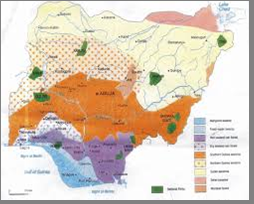CLASS: SS 1
SUBJECT: BIOLOGY PERIODS 2:
DURATION: 45 MINUTES
TOPIC: BASIC ECOLOGICAL CONCEPT
SUBTOPIC 1: TYPES OF ECOLOGY
SUBTOPIC 2: ECOLOGICAL CONCEPTS
SUBTOPIC 3: COMPONENTS OF ECOSYSTEM AND BIOMES
PREVIOUS KNOWLEDGE: STUDENTS AND FAMILIAR WITH THE
TOPIC
OBJECTIVES: At The End Of The Period(s), students should be able to:
Period 1: State the types of ecology and the components of any ecosystem
Period 2: Mention major local biotic communities and give names of organisms typical of each community. Briefly describe different types of communities.
REFERENCES:
Essential biology for senior secondary schools by M.C. Michael 130-135.Modern Biology for senior secondary schools Pg. 88-89.
CONTENT
Ecology is the study of living organisms in relation to their environment. Ecology can be divided into autecology and synecology. Ecological concepts include: environment, biosphere, lithosphere, hydrosphere, atmosphere, habitat, niche, population, biome and ecosystem.
Ecosystem is the community of living organisms functioning in interacting with their non-living environment. The ecosystem consists of the biotic (producers, consumers and decomposers) and abiotic (non living part-resources and conditions such as carbon dioxide, water, nitrogen, Phosphorus, etc, air, soil, temperature, light intensity, humidity, water, currents etc.
BIOMES: These are large natural terrestrial ecosystems.
A biome can be identified by its vegetation which is determined by climatic factors most especially rainfall and temperature e.g. equatorial and tropical area with high temperature have torpical forests which give way to tropical grassland when the annual rainforest is low (about 300-1000mm) or deserts with extremely low rainfall (below 300mm)), coniferous and deciduous forests are found in temperate regions while trees, plains (tundra) are found in cold arctic regions.
LOCAL BIOMES: Nigeria lies in the tropics just above the equator within latitudes 100N and 140N. Nigeria is characterized by high temperature (25oC – 320C) and mean annual rainfall of about 500mm (in the north) to 2,500mm (in the coastal regions ) The local biotic communities that can be found in Nigeria include
- Tropical rainforests: It covers Crossriver, Imo, Ogun, Ondo, Rivers, Abia, Lagos, Bayelsa, Akwa Ibom, Anambra, Edo, Detal and parts of Oyo. The mean annual temperature is 270C, high rainfall of above 2,800mm (280cm) and high relative humidity. It is dense with tall broad leaved trees mostly evergreen. Trees that can be found in include African walnut, Obeche, Ebony, Mahogany, Opepe and iroko birds, snakes, chameleon, monkeys, squirrels are among the animal that can be found there.
- Mangrove swampforest can be found in Delta, Rivers, Bayelsa, Ogun, Akwa Ibom, Lagos and Cross River. The climate is also hot and wet like the tropical rainforest throughout the year, about 2,500mm (250cm) rain and temperature of about 260 it has small evergreen broadleaved trees with prop roots and breathing roots to enable them grow and survive in the shallow, brackish water or soil. White and red mangrove, coconut and raffia palm can be found in these swamp. Crabs, snakes, birds, oysters, kingfish are animals found in the swamp.
- Northern Guinea Savanah: Can be found in Kaduna, Bauchi, Niger Plateau, Kano, Taraba, and Adamawa. It has a hot wet season and cool dry season. The annual rainfall is about 50 -100cm and has scattered, short deciduous trees as well as short but numerous grasses. Acacia, date palm,, baobab, silk, cotton plants can be found in the region. Lions, leopards, antelopes, lizards, deers, snake are found in the area.
- Southern Sudan Savanna can be found in Enugu, Kwara, Ogyo, Osun, Ekiti, Kogi and Benue. It is the largest local biotic community in Nigeria with rainfall of 100 -150cm. It has tall broad leaved trees and tall grasses. The trees are scattered and deciduous (shed their leaves during dry season) Shea butter, Isobellina, locust bean, lions, zebra, leopards and antelopes can be found.
- Sahel Savannah: can be found only in the extreme northern parts of Nigeria like Katsina, Sokoto, Yobe, Zamfara, Kano, Jigawa, Kebi and Borno. It has high temperature and very low rainfall (below 50cm annually) It has short scanty grasses and short shrbs or trees that are drought resistant e.g. gum Arabic, Acacia and date palm.
- Desert can be found at the northern borders of Sokoto, Borno, Katsina, Jigawa and Yobe. It has little or no rainfall in most of the year and the temperature is always The few grasses, shrubs and trees found there e.g. Baobab and cacti trees have special adaptive features like swollen succulent stems, long roots, absence of leaves, presence of thorns.
The major biomes of the world include mangrove swamps, shrubs, desert, savannah, afro-alpine and tropical rainforest.
INSTRUCTIONAL MATERIALS: Pictures showing the major biomes found in Nigeria.

TEACHING METHODS PROCEDURES
Step I: Teacher revises last term’s topic with the students
Step II: Teacher introduces the new topic by explaining what ecology and ecosystem means
Step III: Teacher explains what a biome means and mentions the characteristics of the local biomes found Higenia.
Step IV: Teacher allows students to ask questions and writes notes under content on the board.
ACTIVITIES: (CLASSWORK)
PERIOD 1: Students define Ecology, the types and discuss the ecological concepts
PERIOD 2: Students discuss the types of biome found in Nigeria Evaluation.
PERIOD 1: What Ecosystem? List 4 abiotic factors
PERIOD 2: What is a biome? Mention two biomes in Nigeira.
SUMMARY/CONCLUSION: Teacher summarizes the topic, marks the students notes and makes corrections where necessary.
ASSIGNMENT(S)
PERIOD 1: With the aid of a map, describe the local biotic communities in Nigeria
PERIOD 2: Describe the location and characteristics of 3 of the biomes in Nigeria.